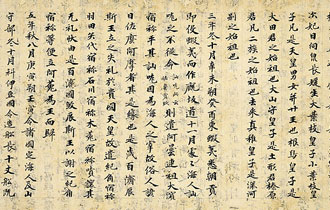Pages |
Kanbun, in one form or another, continued to evolve in Japan. One thousand one hundred years after its introduction, it still retained its position as the most learned form of writing. While its fortunes rose and fell based on the political, social and economic conditions in Japan, as late as the mid-nineteenth century, it was still considered the most proper form of expression. It continued to be closely associated with the state and the power of the elites. During the Edo era (A.D. 1600-1868), because of the Tokugawa revival of Confucianism, kanbun's popularity and widespread usage rivaled that of the Heian period among the ruling class. However, few even in this class still wrote in pure Chinese. Indeed, official documents were often written in a variant form called wakankonkōbun (a hybrid form which uses Chinese characters as nouns, verbs, and kana syllabary for verb endings and other elements). As Japan was ushered into modernity with the Meiji Restoration in 1868, kanbun began to lose its authority. The successful Chinese models of the previous centuries could no longer offer solutions to the problems faced by the Meiji leadership. The demands of creating a modern nation-state made difficult the maintenance of a language built upon an archaic, aristocratic form of writing with few links to the spoken language. Although other forms of writing existed, including sōrōbun and the gesaku forms, no one written (or spoken) form was used by everyone in Japan. Other genres of writing such as poetry and diaries in literature were done in yet another style of writing.
A Script Reform
In the years immediately following the Meiji Restoration, the new leadership had other, more pressing tasks to complete before they could move on to the reform of the Japanese written language. They were engaged in the creation of a state strong enough to protect itself from the imperial designs of the Western powers. However, the ruling elites discovered after a couple of decades of reform that although Japan had become strong enough to protect its national sovereignty, it could not catch up with the Western powers without having a strong educational system. This could only happen if the language itself—the actual mode of transmission for new knowledge—was up to the task. Instead, the Japanese language in the early decades of the Meiji era can best be described as being in a state of chaos. Communication difficulties were compounded in the written form because the various spoken dialects bore little resemblance to kanbun. Literacy rates were very low perhaps because one had to master approximately 10,000 characters in order to be considered fully competent in kanbun. Of course, some segments of Japanese society were literate in their own dialect and many, particularly in the Osaka and Tokyo areas, used the language for commerce. Those with training in a specific job or profession could also communicate. For example, doctors could communicate with doctors, merchants with merchants, craftsmen with craftsmen and priests with priests. Nonetheless, as Japan entered the Meiji era, it needed the written and spoken forms of the language that were capable of acting as a unifying force for the new nation.
Though several prominent language-reform advocates had begun to consider how written Japanese might best be reformed, the ruling elites could reach no consensus in the first two decades of the Meiji era. Men of renown such as Maejima Hisoka (1835-1919), Mori Arinori (1847-1889) and Fukuzawa Yukichi (1834-1901) had suggested ways the official Japanese language (kanbun) might be simplified or somehow made more accessible to the average Japanese citizen. Mori, who would later become Minister of Education, had even considered a proposal to substitute English for Japanese! Nishi Amane (1829-1897), a prominent script-reform advocate of the era, recommended the abandonment of Chinese characters and that the Latin alphabet be adopted to write Japanese.
Pages |











